Cross Cultural Management: Trompenaars Model, Australia & Intelligence
VerifiedAdded on 2023/06/07
|7
|2233
|253
Essay
AI Summary
This essay explores cross-cultural management through the lens of Trompenaars' model, analyzing its application to Australia's national culture and discussing the significance of cultural intelligence. It examines how Trompenaars' seven cultural dimensions manifest in Australia, highlighting traits like universalism, individualism, and a preference for neutral emotions. The essay also emphasizes the importance of understanding population demographics for effective decision-making and delves into the concept of cultural intelligence, particularly its role in fostering cultural competency. Furthermore, it discusses Wesfarmers' corporate values, emphasizing ethics, legal compliance, customer focus, and environmental responsibility. The essay concludes by highlighting the need for individuals to acquire relevant skills and cultivate a strong work ethic to become indispensable assets in today's dynamic work environment. Desklib provides access to a variety of resources, including past papers and solved assignments, to aid students in their studies.
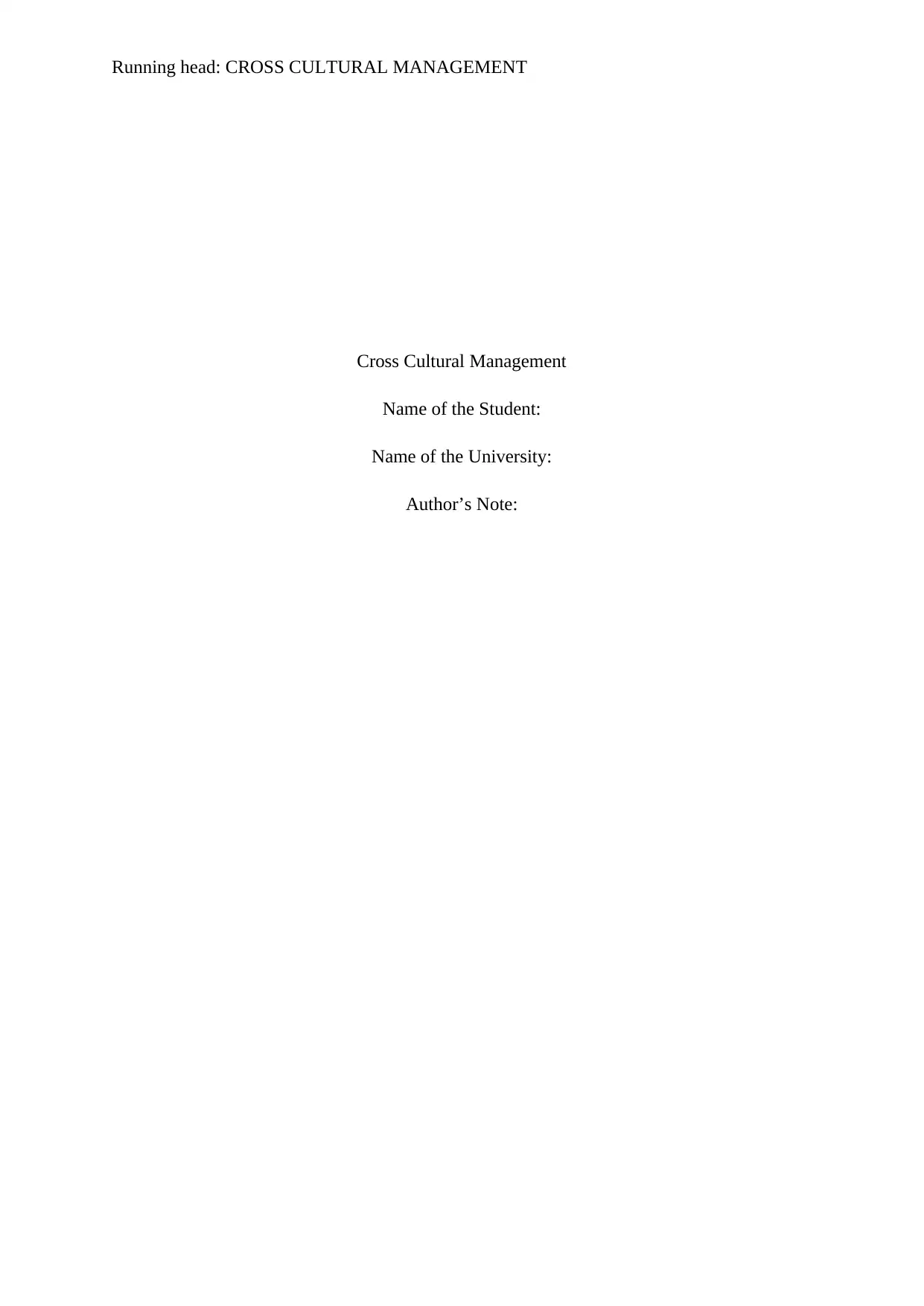
Running head: CROSS CULTURAL MANAGEMENT
Cross Cultural Management
Name of the Student:
Name of the University:
Author’s Note:
Cross Cultural Management
Name of the Student:
Name of the University:
Author’s Note:
Paraphrase This Document
Need a fresh take? Get an instant paraphrase of this document with our AI Paraphraser

1CROSS CULTURAL MANAGEMENT
Introduction
The factor of culture plays a significant role in the lives of the individuals and to a
great extent determines the values, beliefs and other aspects of the lives of the human beings
(Trompenaars and Greene 2016). The importance that the entity of culture holds within the
lives of the human beings in represented by the diverse theories as well as the models of
culture like Hofstede’s model, Trompenaar’s model and others which try to explain the
national cultures of the diverse nations in an effective manner. At the same time the factor of
cultural intelligence has also gained significance in the present times and helps a particular
individual to understand the culture of others in an effective manner. This journal will discuss
about the cultural model of Trompenaar and the analysis of the national culture of Australia
on the basis of this particular model. The paper will also discuss about the concept of cultural
intelligence and also the different corporate values that the company Wesfarmers follows.
Question 1
The seven important entities of the cultural dimension of Trompenaar which is often
used to define or explain the national culture of a particular nation can also be seen as the
seven layers of the onion model of culture (Trompenaars and Greene 2016). These seven
layers of the onion model are often used by the diverse individuals as well as organizations
for the understanding of the effective manner in which the problem of cross cultural
miscommunication can be effectively mitigated which has emerged as one of the major
problems that the diverse organizations of the world are experiencing at the current because
of the diversification of the business world (Trompenaars and Greene 2016). There are seven
layers of Trompenaar’s model of culture or onion, namely, universalism versus particularism,
individualism versus collectivism, neutral versus emotional, specific versus diffuse,
achievement versus ascription, sequential versus synchronic, internal control versus external
control (Trompenaars and Greene 2016).
Question 2
I would like to mention at this particular juncture that when the Trompenaar’s model
of national culture is applied to the nation of Australia it reveals insight details. For example,
the nation of Australia clearly shows universal cultural traits in comparison to the particular
cultural tendencies depicted by the national cultures of other nations of the world (Sharma,
Introduction
The factor of culture plays a significant role in the lives of the individuals and to a
great extent determines the values, beliefs and other aspects of the lives of the human beings
(Trompenaars and Greene 2016). The importance that the entity of culture holds within the
lives of the human beings in represented by the diverse theories as well as the models of
culture like Hofstede’s model, Trompenaar’s model and others which try to explain the
national cultures of the diverse nations in an effective manner. At the same time the factor of
cultural intelligence has also gained significance in the present times and helps a particular
individual to understand the culture of others in an effective manner. This journal will discuss
about the cultural model of Trompenaar and the analysis of the national culture of Australia
on the basis of this particular model. The paper will also discuss about the concept of cultural
intelligence and also the different corporate values that the company Wesfarmers follows.
Question 1
The seven important entities of the cultural dimension of Trompenaar which is often
used to define or explain the national culture of a particular nation can also be seen as the
seven layers of the onion model of culture (Trompenaars and Greene 2016). These seven
layers of the onion model are often used by the diverse individuals as well as organizations
for the understanding of the effective manner in which the problem of cross cultural
miscommunication can be effectively mitigated which has emerged as one of the major
problems that the diverse organizations of the world are experiencing at the current because
of the diversification of the business world (Trompenaars and Greene 2016). There are seven
layers of Trompenaar’s model of culture or onion, namely, universalism versus particularism,
individualism versus collectivism, neutral versus emotional, specific versus diffuse,
achievement versus ascription, sequential versus synchronic, internal control versus external
control (Trompenaars and Greene 2016).
Question 2
I would like to mention at this particular juncture that when the Trompenaar’s model
of national culture is applied to the nation of Australia it reveals insight details. For example,
the nation of Australia clearly shows universal cultural traits in comparison to the particular
cultural tendencies depicted by the national cultures of other nations of the world (Sharma,
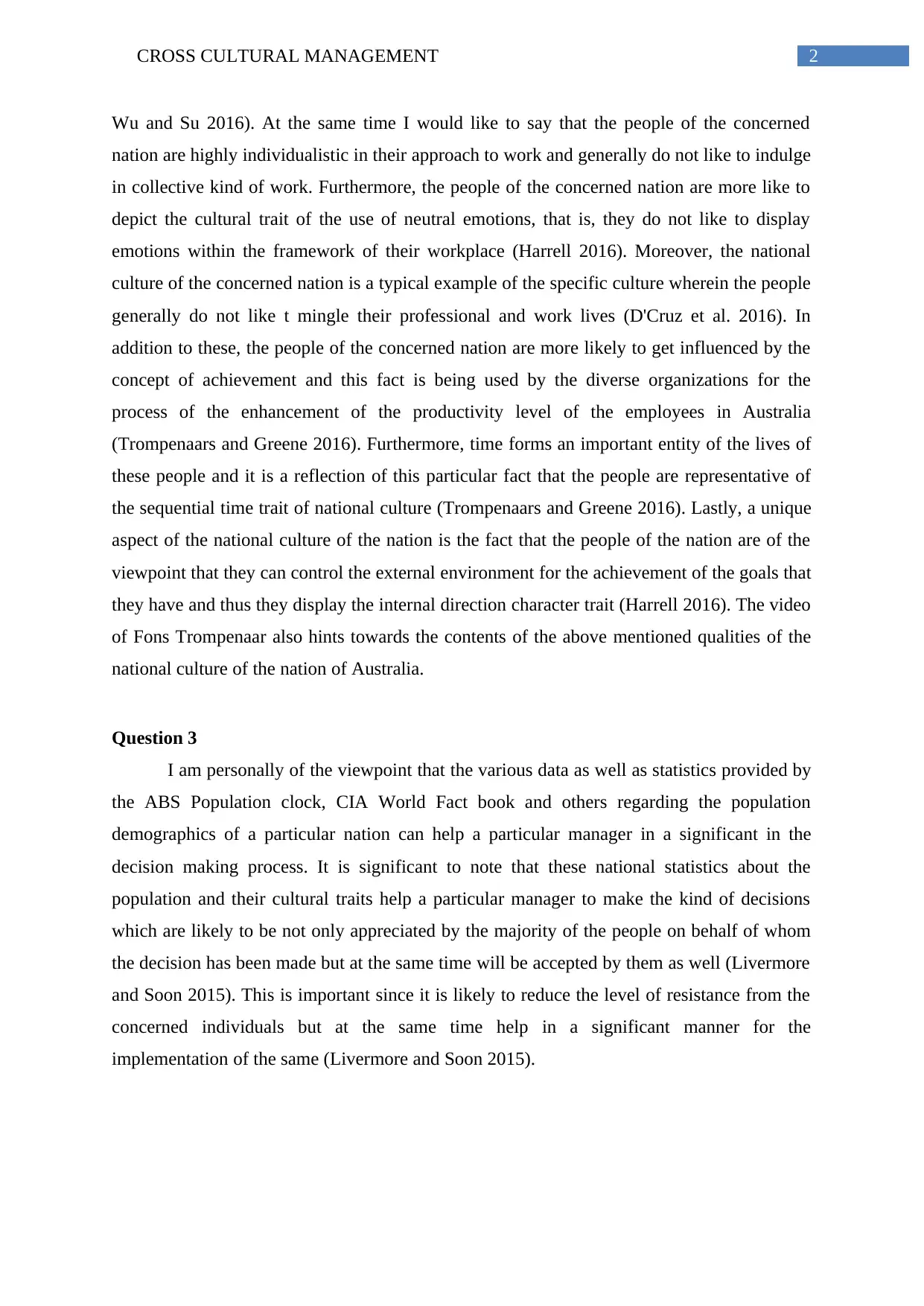
2CROSS CULTURAL MANAGEMENT
Wu and Su 2016). At the same time I would like to say that the people of the concerned
nation are highly individualistic in their approach to work and generally do not like to indulge
in collective kind of work. Furthermore, the people of the concerned nation are more like to
depict the cultural trait of the use of neutral emotions, that is, they do not like to display
emotions within the framework of their workplace (Harrell 2016). Moreover, the national
culture of the concerned nation is a typical example of the specific culture wherein the people
generally do not like t mingle their professional and work lives (D'Cruz et al. 2016). In
addition to these, the people of the concerned nation are more likely to get influenced by the
concept of achievement and this fact is being used by the diverse organizations for the
process of the enhancement of the productivity level of the employees in Australia
(Trompenaars and Greene 2016). Furthermore, time forms an important entity of the lives of
these people and it is a reflection of this particular fact that the people are representative of
the sequential time trait of national culture (Trompenaars and Greene 2016). Lastly, a unique
aspect of the national culture of the nation is the fact that the people of the nation are of the
viewpoint that they can control the external environment for the achievement of the goals that
they have and thus they display the internal direction character trait (Harrell 2016). The video
of Fons Trompenaar also hints towards the contents of the above mentioned qualities of the
national culture of the nation of Australia.
Question 3
I am personally of the viewpoint that the various data as well as statistics provided by
the ABS Population clock, CIA World Fact book and others regarding the population
demographics of a particular nation can help a particular manager in a significant in the
decision making process. It is significant to note that these national statistics about the
population and their cultural traits help a particular manager to make the kind of decisions
which are likely to be not only appreciated by the majority of the people on behalf of whom
the decision has been made but at the same time will be accepted by them as well (Livermore
and Soon 2015). This is important since it is likely to reduce the level of resistance from the
concerned individuals but at the same time help in a significant manner for the
implementation of the same (Livermore and Soon 2015).
Wu and Su 2016). At the same time I would like to say that the people of the concerned
nation are highly individualistic in their approach to work and generally do not like to indulge
in collective kind of work. Furthermore, the people of the concerned nation are more like to
depict the cultural trait of the use of neutral emotions, that is, they do not like to display
emotions within the framework of their workplace (Harrell 2016). Moreover, the national
culture of the concerned nation is a typical example of the specific culture wherein the people
generally do not like t mingle their professional and work lives (D'Cruz et al. 2016). In
addition to these, the people of the concerned nation are more likely to get influenced by the
concept of achievement and this fact is being used by the diverse organizations for the
process of the enhancement of the productivity level of the employees in Australia
(Trompenaars and Greene 2016). Furthermore, time forms an important entity of the lives of
these people and it is a reflection of this particular fact that the people are representative of
the sequential time trait of national culture (Trompenaars and Greene 2016). Lastly, a unique
aspect of the national culture of the nation is the fact that the people of the nation are of the
viewpoint that they can control the external environment for the achievement of the goals that
they have and thus they display the internal direction character trait (Harrell 2016). The video
of Fons Trompenaar also hints towards the contents of the above mentioned qualities of the
national culture of the nation of Australia.
Question 3
I am personally of the viewpoint that the various data as well as statistics provided by
the ABS Population clock, CIA World Fact book and others regarding the population
demographics of a particular nation can help a particular manager in a significant in the
decision making process. It is significant to note that these national statistics about the
population and their cultural traits help a particular manager to make the kind of decisions
which are likely to be not only appreciated by the majority of the people on behalf of whom
the decision has been made but at the same time will be accepted by them as well (Livermore
and Soon 2015). This is important since it is likely to reduce the level of resistance from the
concerned individuals but at the same time help in a significant manner for the
implementation of the same (Livermore and Soon 2015).
⊘ This is a preview!⊘
Do you want full access?
Subscribe today to unlock all pages.

Trusted by 1+ million students worldwide
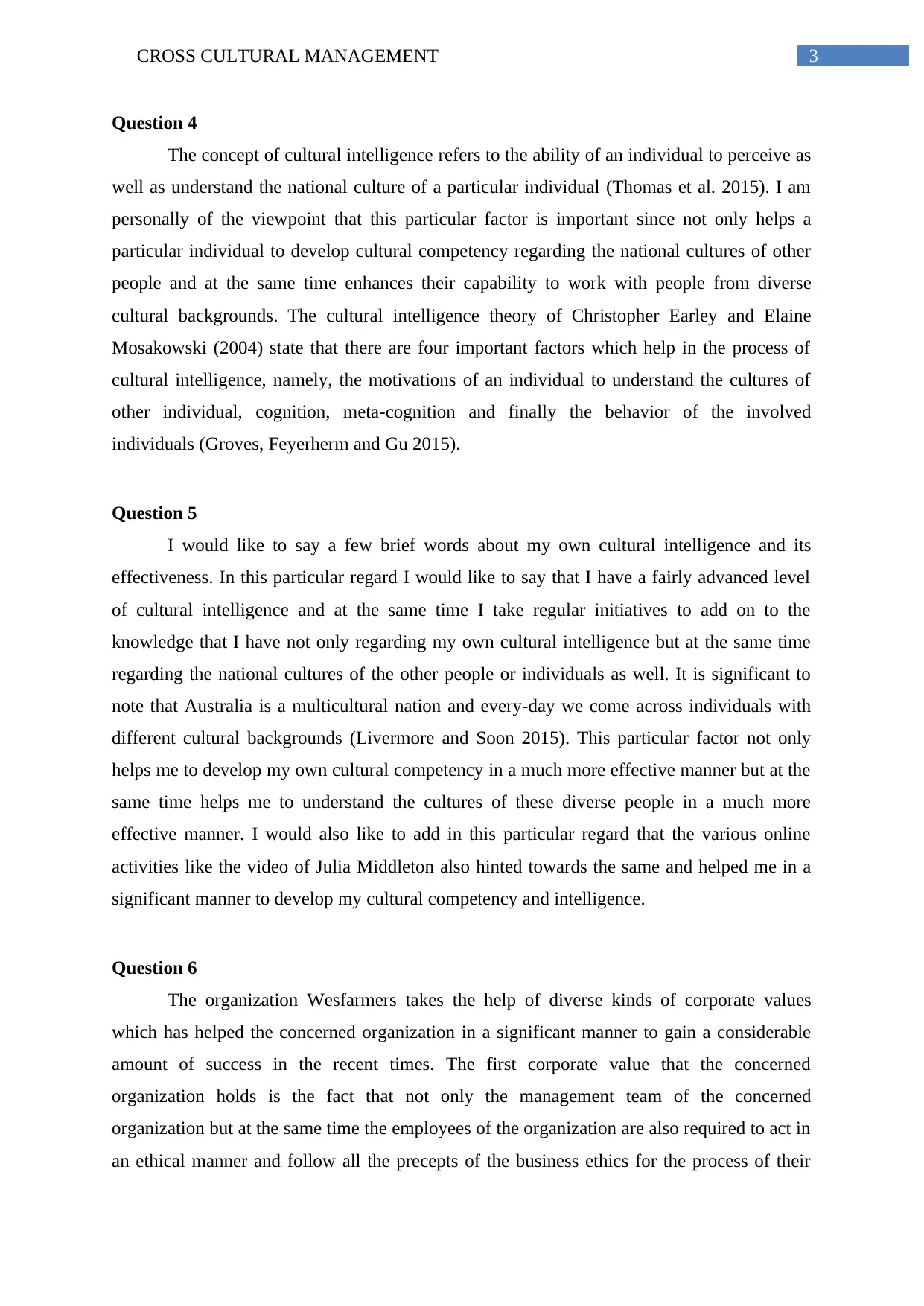
3CROSS CULTURAL MANAGEMENT
Question 4
The concept of cultural intelligence refers to the ability of an individual to perceive as
well as understand the national culture of a particular individual (Thomas et al. 2015). I am
personally of the viewpoint that this particular factor is important since not only helps a
particular individual to develop cultural competency regarding the national cultures of other
people and at the same time enhances their capability to work with people from diverse
cultural backgrounds. The cultural intelligence theory of Christopher Earley and Elaine
Mosakowski (2004) state that there are four important factors which help in the process of
cultural intelligence, namely, the motivations of an individual to understand the cultures of
other individual, cognition, meta-cognition and finally the behavior of the involved
individuals (Groves, Feyerherm and Gu 2015).
Question 5
I would like to say a few brief words about my own cultural intelligence and its
effectiveness. In this particular regard I would like to say that I have a fairly advanced level
of cultural intelligence and at the same time I take regular initiatives to add on to the
knowledge that I have not only regarding my own cultural intelligence but at the same time
regarding the national cultures of the other people or individuals as well. It is significant to
note that Australia is a multicultural nation and every-day we come across individuals with
different cultural backgrounds (Livermore and Soon 2015). This particular factor not only
helps me to develop my own cultural competency in a much more effective manner but at the
same time helps me to understand the cultures of these diverse people in a much more
effective manner. I would also like to add in this particular regard that the various online
activities like the video of Julia Middleton also hinted towards the same and helped me in a
significant manner to develop my cultural competency and intelligence.
Question 6
The organization Wesfarmers takes the help of diverse kinds of corporate values
which has helped the concerned organization in a significant manner to gain a considerable
amount of success in the recent times. The first corporate value that the concerned
organization holds is the fact that not only the management team of the concerned
organization but at the same time the employees of the organization are also required to act in
an ethical manner and follow all the precepts of the business ethics for the process of their
Question 4
The concept of cultural intelligence refers to the ability of an individual to perceive as
well as understand the national culture of a particular individual (Thomas et al. 2015). I am
personally of the viewpoint that this particular factor is important since not only helps a
particular individual to develop cultural competency regarding the national cultures of other
people and at the same time enhances their capability to work with people from diverse
cultural backgrounds. The cultural intelligence theory of Christopher Earley and Elaine
Mosakowski (2004) state that there are four important factors which help in the process of
cultural intelligence, namely, the motivations of an individual to understand the cultures of
other individual, cognition, meta-cognition and finally the behavior of the involved
individuals (Groves, Feyerherm and Gu 2015).
Question 5
I would like to say a few brief words about my own cultural intelligence and its
effectiveness. In this particular regard I would like to say that I have a fairly advanced level
of cultural intelligence and at the same time I take regular initiatives to add on to the
knowledge that I have not only regarding my own cultural intelligence but at the same time
regarding the national cultures of the other people or individuals as well. It is significant to
note that Australia is a multicultural nation and every-day we come across individuals with
different cultural backgrounds (Livermore and Soon 2015). This particular factor not only
helps me to develop my own cultural competency in a much more effective manner but at the
same time helps me to understand the cultures of these diverse people in a much more
effective manner. I would also like to add in this particular regard that the various online
activities like the video of Julia Middleton also hinted towards the same and helped me in a
significant manner to develop my cultural competency and intelligence.
Question 6
The organization Wesfarmers takes the help of diverse kinds of corporate values
which has helped the concerned organization in a significant manner to gain a considerable
amount of success in the recent times. The first corporate value that the concerned
organization holds is the fact that not only the management team of the concerned
organization but at the same time the employees of the organization are also required to act in
an ethical manner and follow all the precepts of the business ethics for the process of their
Paraphrase This Document
Need a fresh take? Get an instant paraphrase of this document with our AI Paraphraser

4CROSS CULTURAL MANAGEMENT
business (sustainability.wesfarmers.com.au 2018). The second corporate value that the
organization and its employees need to follow is the fact that they need to abide by the
various precepts as well as stipulations of the legislations provided by the national
government of the nation of Australia but at the same time of the other nations in which they
are operational (sustainability.wesfarmers.com.au 2018). Thirdly, the entire culture of the
concerned company is focused towards meeting the demands and the expectations of the
customers (sustainability.wesfarmers.com.au 2018). Fourthly, the concerned organizations
and also its employees are required to treat its suppliers in an ethical as well as respectful
manner (sustainability.wesfarmers.com.au 2018). Fifthly, the concerned organization not
only needs to be responsible but at the same time respectful towards the various diverse
employees (sustainability.wesfarmers.com.au 2018). Finally, the organization and also the
employees are required to indulge in the kind of activities which is likely to add a positive or
significant value towards the environment and the society (sustainability.wesfarmers.com.au
2018).
Question 7
The dynamic nature of the present day world of employability had made it imperative
for the individuals to acquire the kind of skills which are not only likely to make them
contribute a positive value to the organization but at the same time make themselves an
indispensible part of the concerned organization (Forbes.com 2018). To do this I would first
of all have to analyze the key strengths as well as the weaknesses of my own character and
work on the weaknesses which I have so as to overcome or mitigate their effects. In addition
to this, hard work is another factor which is likely to make myself an indispensible part of the
concerned organization. It is significant to note that the various organizations generally look
for the employees who are more hard working than the others (Forbes.com 2018).
Furthermore, the mistake that the majority of the individuals end up making is the fact that
they end up acquiring the kind of skills that are not relevant to the job role that they are
supposed to perform within the framework of the concerned organization (Forbes.com 2018).
Thus, within the framework of an organization I would try to acquire the kind of skills which
are likely to help me to perform the job roles which have been assigned to me in a much more
effective manner.
business (sustainability.wesfarmers.com.au 2018). The second corporate value that the
organization and its employees need to follow is the fact that they need to abide by the
various precepts as well as stipulations of the legislations provided by the national
government of the nation of Australia but at the same time of the other nations in which they
are operational (sustainability.wesfarmers.com.au 2018). Thirdly, the entire culture of the
concerned company is focused towards meeting the demands and the expectations of the
customers (sustainability.wesfarmers.com.au 2018). Fourthly, the concerned organizations
and also its employees are required to treat its suppliers in an ethical as well as respectful
manner (sustainability.wesfarmers.com.au 2018). Fifthly, the concerned organization not
only needs to be responsible but at the same time respectful towards the various diverse
employees (sustainability.wesfarmers.com.au 2018). Finally, the organization and also the
employees are required to indulge in the kind of activities which is likely to add a positive or
significant value towards the environment and the society (sustainability.wesfarmers.com.au
2018).
Question 7
The dynamic nature of the present day world of employability had made it imperative
for the individuals to acquire the kind of skills which are not only likely to make them
contribute a positive value to the organization but at the same time make themselves an
indispensible part of the concerned organization (Forbes.com 2018). To do this I would first
of all have to analyze the key strengths as well as the weaknesses of my own character and
work on the weaknesses which I have so as to overcome or mitigate their effects. In addition
to this, hard work is another factor which is likely to make myself an indispensible part of the
concerned organization. It is significant to note that the various organizations generally look
for the employees who are more hard working than the others (Forbes.com 2018).
Furthermore, the mistake that the majority of the individuals end up making is the fact that
they end up acquiring the kind of skills that are not relevant to the job role that they are
supposed to perform within the framework of the concerned organization (Forbes.com 2018).
Thus, within the framework of an organization I would try to acquire the kind of skills which
are likely to help me to perform the job roles which have been assigned to me in a much more
effective manner.
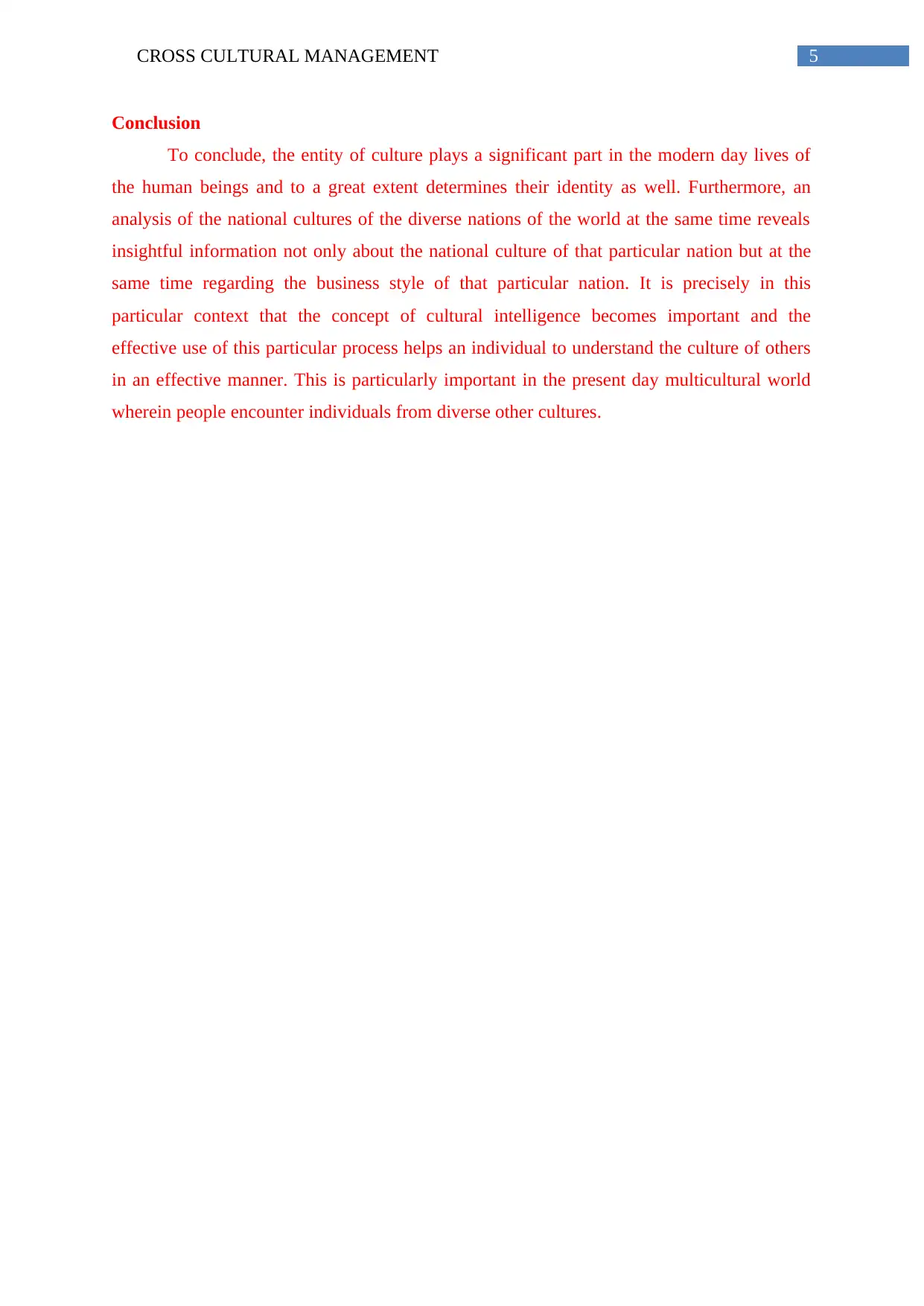
5CROSS CULTURAL MANAGEMENT
Conclusion
To conclude, the entity of culture plays a significant part in the modern day lives of
the human beings and to a great extent determines their identity as well. Furthermore, an
analysis of the national cultures of the diverse nations of the world at the same time reveals
insightful information not only about the national culture of that particular nation but at the
same time regarding the business style of that particular nation. It is precisely in this
particular context that the concept of cultural intelligence becomes important and the
effective use of this particular process helps an individual to understand the culture of others
in an effective manner. This is particularly important in the present day multicultural world
wherein people encounter individuals from diverse other cultures.
Conclusion
To conclude, the entity of culture plays a significant part in the modern day lives of
the human beings and to a great extent determines their identity as well. Furthermore, an
analysis of the national cultures of the diverse nations of the world at the same time reveals
insightful information not only about the national culture of that particular nation but at the
same time regarding the business style of that particular nation. It is precisely in this
particular context that the concept of cultural intelligence becomes important and the
effective use of this particular process helps an individual to understand the culture of others
in an effective manner. This is particularly important in the present day multicultural world
wherein people encounter individuals from diverse other cultures.
⊘ This is a preview!⊘
Do you want full access?
Subscribe today to unlock all pages.

Trusted by 1+ million students worldwide
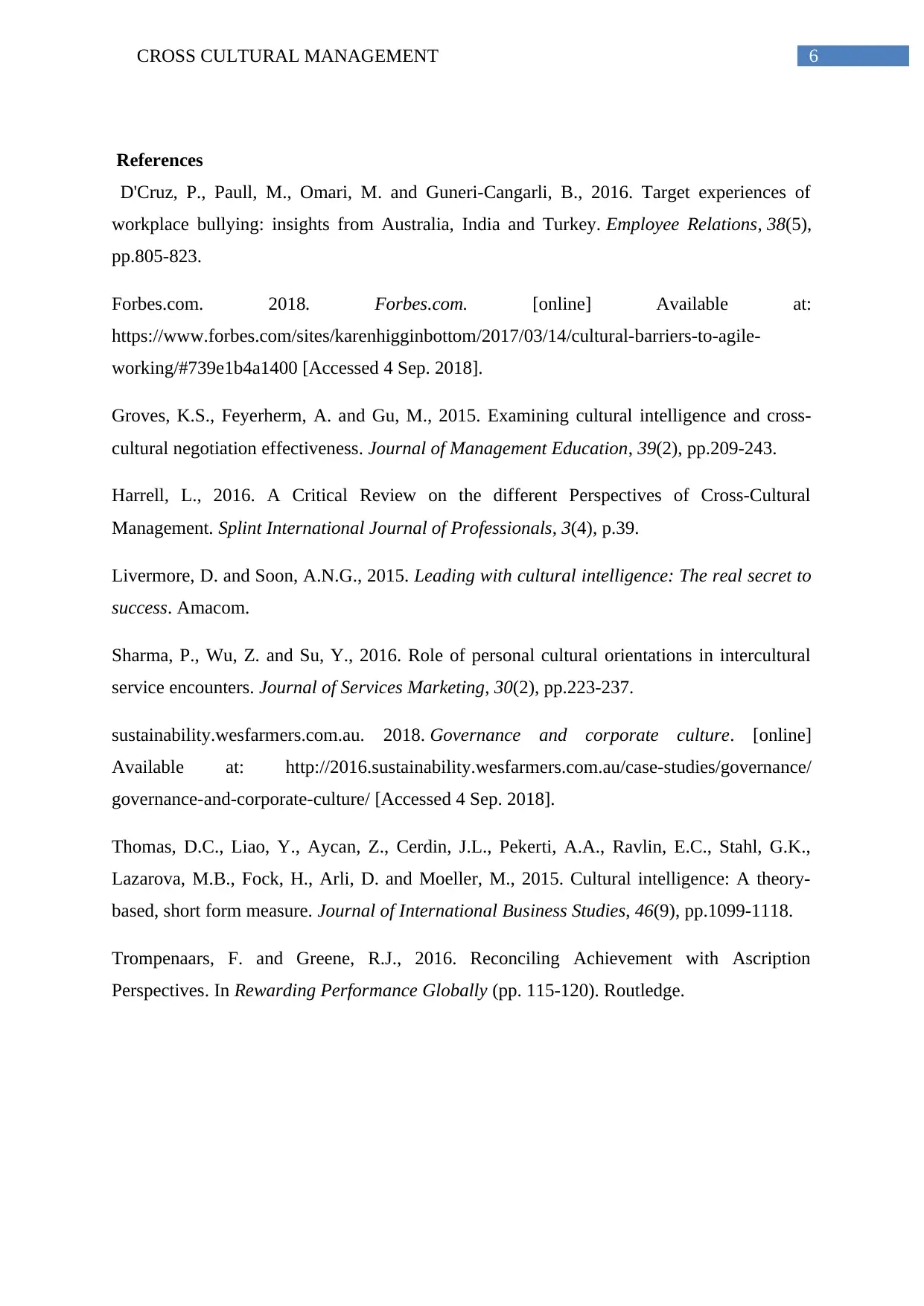
6CROSS CULTURAL MANAGEMENT
References
D'Cruz, P., Paull, M., Omari, M. and Guneri-Cangarli, B., 2016. Target experiences of
workplace bullying: insights from Australia, India and Turkey. Employee Relations, 38(5),
pp.805-823.
Forbes.com. 2018. Forbes.com. [online] Available at:
https://www.forbes.com/sites/karenhigginbottom/2017/03/14/cultural-barriers-to-agile-
working/#739e1b4a1400 [Accessed 4 Sep. 2018].
Groves, K.S., Feyerherm, A. and Gu, M., 2015. Examining cultural intelligence and cross-
cultural negotiation effectiveness. Journal of Management Education, 39(2), pp.209-243.
Harrell, L., 2016. A Critical Review on the different Perspectives of Cross-Cultural
Management. Splint International Journal of Professionals, 3(4), p.39.
Livermore, D. and Soon, A.N.G., 2015. Leading with cultural intelligence: The real secret to
success. Amacom.
Sharma, P., Wu, Z. and Su, Y., 2016. Role of personal cultural orientations in intercultural
service encounters. Journal of Services Marketing, 30(2), pp.223-237.
sustainability.wesfarmers.com.au. 2018. Governance and corporate culture. [online]
Available at: http://2016.sustainability.wesfarmers.com.au/case-studies/governance/
governance-and-corporate-culture/ [Accessed 4 Sep. 2018].
Thomas, D.C., Liao, Y., Aycan, Z., Cerdin, J.L., Pekerti, A.A., Ravlin, E.C., Stahl, G.K.,
Lazarova, M.B., Fock, H., Arli, D. and Moeller, M., 2015. Cultural intelligence: A theory-
based, short form measure. Journal of International Business Studies, 46(9), pp.1099-1118.
Trompenaars, F. and Greene, R.J., 2016. Reconciling Achievement with Ascription
Perspectives. In Rewarding Performance Globally (pp. 115-120). Routledge.
References
D'Cruz, P., Paull, M., Omari, M. and Guneri-Cangarli, B., 2016. Target experiences of
workplace bullying: insights from Australia, India and Turkey. Employee Relations, 38(5),
pp.805-823.
Forbes.com. 2018. Forbes.com. [online] Available at:
https://www.forbes.com/sites/karenhigginbottom/2017/03/14/cultural-barriers-to-agile-
working/#739e1b4a1400 [Accessed 4 Sep. 2018].
Groves, K.S., Feyerherm, A. and Gu, M., 2015. Examining cultural intelligence and cross-
cultural negotiation effectiveness. Journal of Management Education, 39(2), pp.209-243.
Harrell, L., 2016. A Critical Review on the different Perspectives of Cross-Cultural
Management. Splint International Journal of Professionals, 3(4), p.39.
Livermore, D. and Soon, A.N.G., 2015. Leading with cultural intelligence: The real secret to
success. Amacom.
Sharma, P., Wu, Z. and Su, Y., 2016. Role of personal cultural orientations in intercultural
service encounters. Journal of Services Marketing, 30(2), pp.223-237.
sustainability.wesfarmers.com.au. 2018. Governance and corporate culture. [online]
Available at: http://2016.sustainability.wesfarmers.com.au/case-studies/governance/
governance-and-corporate-culture/ [Accessed 4 Sep. 2018].
Thomas, D.C., Liao, Y., Aycan, Z., Cerdin, J.L., Pekerti, A.A., Ravlin, E.C., Stahl, G.K.,
Lazarova, M.B., Fock, H., Arli, D. and Moeller, M., 2015. Cultural intelligence: A theory-
based, short form measure. Journal of International Business Studies, 46(9), pp.1099-1118.
Trompenaars, F. and Greene, R.J., 2016. Reconciling Achievement with Ascription
Perspectives. In Rewarding Performance Globally (pp. 115-120). Routledge.
1 out of 7
Related Documents
Your All-in-One AI-Powered Toolkit for Academic Success.
+13062052269
info@desklib.com
Available 24*7 on WhatsApp / Email
![[object Object]](/_next/static/media/star-bottom.7253800d.svg)
Unlock your academic potential
Copyright © 2020–2025 A2Z Services. All Rights Reserved. Developed and managed by ZUCOL.




